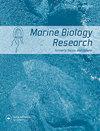Distributional patterns of two sympatric blue crabs (Callinectes) and the implications for conservation management at the South-west Atlantic subtropical shelf
IF 1.2
4区 生物学
Q4 ECOLOGY
引用次数: 0
Abstract
ABSTRACT Changes in species distribution patterns allow managers to monitor the conservation status of species. This study investigated the distribution and segregation in the blue crabs Callinectes danae and Callinectes ornatus in the South-west Atlantic subtropical shelf. We characterized the crabs’ abundance and related it to environmental factors. Abundance expressed as catch per unit effort estimates deviated significantly from crabs’ abundances assessed by years: in Year 1, station S7 showed the highest abundance for C. danae and the lowest for C. ornatus. In Year 2, the abundance of species only differed significantly in station S2. Summer was the season with the highest abundance of C. danae and spring of C. ornatus. Temperature was the environmental factor that modulated the distribution of blue crabs. The crabs presented different spatial and temporal distribution patterns, although there was no evident segregation between species. This ecological study indicates a potential site in the South-west Atlantic subtropical shelf to maintain the reproductive viability of the population.西南大西洋亚热带陆架两种同域蓝蟹的分布格局及其保护管理意义
物种分布格局的变化使管理者能够监测物种的保护状况。本文研究了西南大西洋亚热带陆架蓝蟹(Callinectes danae)和蓝蟹(Callinectes ornatus)的分布和分异。我们描述了蟹的丰度,并将其与环境因素联系起来。以单位努力渔获量估计表示的丰度与按年评估的螃蟹丰度存在显著偏差:在第1年,S7站显示danae的丰度最高,而C. ornatus的丰度最低。第2年,物种丰度仅在S2站位有显著差异。以夏季和春季为最高丰度。温度是影响蓝蟹分布的环境因素。蟹类在时空分布上呈现出不同的分布格局,但物种间没有明显的分异。该生态研究表明,西南大西洋亚热带大陆架是维持该种群繁殖能力的潜在地点。
本文章由计算机程序翻译,如有差异,请以英文原文为准。
求助全文
约1分钟内获得全文
求助全文
来源期刊

Marine Biology Research
生物-海洋与淡水生物学
CiteScore
2.10
自引率
0.00%
发文量
55
审稿时长
6-12 weeks
期刊介绍:
Marine Biology Research (MBRJ) provides a worldwide forum for key information, ideas and discussion on all areas of marine biology and biological oceanography. Founded in 2005 as a merger of two Scandinavian journals, Sarsia and Ophelia, MBRJ is based today at the Institute of Marine Research, Bergen, Norway. The Journal’s scope encompasses basic and applied research from all oceans and marine habitats and on all marine organisms, the main criterium for acceptance being quality.
 求助内容:
求助内容: 应助结果提醒方式:
应助结果提醒方式:


